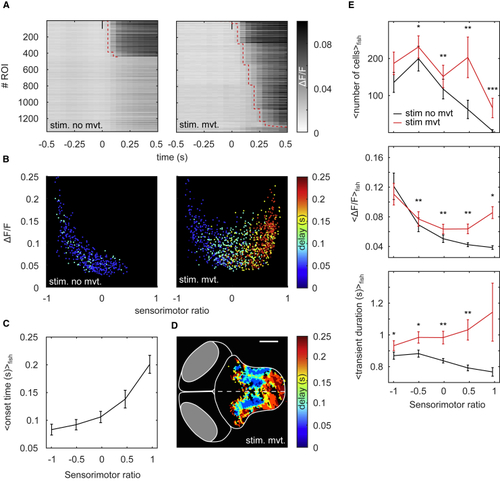Figure 7
- ID
- ZDB-FIG-191230-1453
- Publication
- Privat et al., 2019 - Sensorimotor Transformations in the Zebrafish Auditory System
- Other Figures
- All Figure Page
- Back to All Figure Page
|
Increased Network Activity and Duration of Calcium Transients Mediates Sensorimotor Transformation (A) Example rasters of a single larva averaged over trials for which auditory stimuli induced (stim. mvt.) or did not induce a tail movement (stim. no mvt.). ROIs are sorted by the onset time of their calcium transients. Red dotted line, transient onset. Transient onset was estimated only for ROIs whose activity after stimulation was 2 SDs above their mean activity before stimulation (activity baseline). (B) Example of ΔF/F as a function of sensorimotor ratio; colormap, onset time of the calcium transients. (C) Onset time (mean ± SEM) as a function of sensorimotor ratio for 27 larvae. ROIs were binned into 5 groups based on their sensorimotor ratio. (D) Topography of the onset time for the same larva as in (A) and (B). Scale bar, 100 μm. (E) Top: number of ROIs above the 3 SD threshold for each sensorimotor ratio bin (mean ± SEM). Middle: peak ΔF/F for each bin is shown (mean ± SEM). Bottom: transient duration computed as the full width at half maximum of the calcium transients for each bin is shown (mean ± SEM). Red line, auditory stimulation followed by a tail movement in a 500-ms time window after stimulation onset. Black line, auditory stimulation not followed by a tail movement. Results were pooled across 27 larvae. Bins were compared using the one-tailed Wilcoxon paired signed rank test, and p values were subsequently adjusted using Bonferroni correction. See also |

